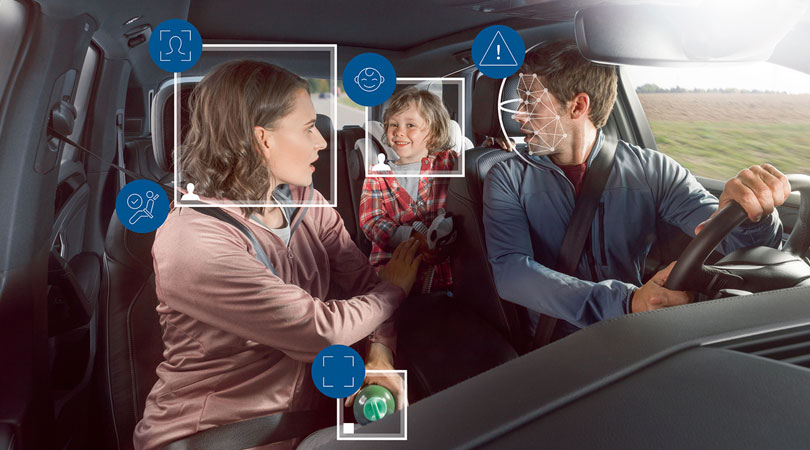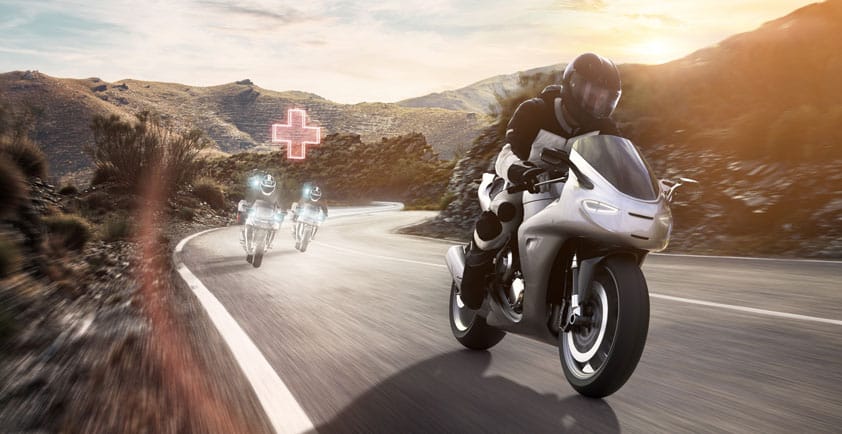

SAFE EYES SAVE LIVES: HOW BOSCH ENGINEERS ARE INNOVATING THE 95-YEAR-OLD SUN VISOR
Bosch’s new Virtual Visor greatly improves driver safety and comfort
>> Sun glare causes thousands of automotive accidents a year, almost two times more than any other weather-related condition.
>> Virtual Visor features a single, transparent LCD panel, a driver-facing camera with AI facial detection and analysis and tracking software.
>> Dr. Steffen Berns: “Some of the simplest innovations make the greatest impact, and Virtual Visor changes the way drivers see the road.”
Farmington Hills, Michigan – Bosch is rethinking driver safety and comfort, bringing one of the most overlooked interior components into the spotlight, the sun visor. The sun causes twice as many car accidents as any other weather-related condition due to temporary blindness. The National Highway Traffic Safety Administration reports thousands sun glare-related car accidents each year, and another study indicates the risk of a car crash is 16 percent higher during bright sunlight than normal weather. The traditional sun visor is not equipped to adequately address this safety concern. At best, it blocks some of the sun from your eyes but along with it, some of your view is blocked as well.
Bosch is offering a solution with the revolutionary Virtual Visor, a transparent LCD and intuitive camera, which replaces the traditional vehicle sun visor completely. As the first reimagined visor in nearly a century, Bosch’s technology utilizes intelligent algorithms to intuitively block the sun’s glare and not the view of the road ahead.
“For most drivers around the world, the visor component as we know it is not enough to avoid hazardous sun glare – especially at dawn and dusk when the sun can greatly decrease drivers’ vision,” said Dr. Steffen Berns, president of Bosch Car Multimedia. “Some of the simplest innovations make the greatest impact, and Virtual Visor changes the way drivers see the road.”
The Virtual Visor, which was honored as a Best of Innovation in the CES 2020 Innovation Awards, was debuted at CES 2020 in Las Vegas. The Virtual Visor was also named as an honoree in the awards competition, which recognizes products across 28 categories. Virtual Visor received the Best of Innovation for the In-Vehicle Entertainment & Safety category, as it received the highest ratings from a panel of judges that includes designers, engineers and members of the tech media.


A sun visor fit for the future
Virtual Visor links an LCD panel with a driver or occupant-monitoring camera to track the sun’s casted shadow on the driver’s face. The system uses artificial intelligence to locate the driver within the image from the driver-facing camera. It also utilizes AI to determine the landmarks on the face ‒ including where the eyes, nose and mouth are located ‒ so that it can identify shadows on the face. The algorithm analyzes the driver’s view, darkening only the section of the display through which light hits the driver’s eyes. The rest of the display remains transparent, no longer obscuring a large section of the driver’s field of vision.
“We discovered early in the development that users adjust their traditional sun visors to always cast a shadow on their own eyes,” said Jason Zink, technical expert for Bosch in North America and one of the co-creators of the Virtual Visor. “This realization was profound in helping simplify the product concept and fuel the design of the technology.”
The creative use of liquid crystal technology to block a specific light source decreases dangerous sun glare, driver discomfort and accident risk; it also increases driver visibility, comfort and safety.
Innovation from the recycling bin
From the original ideation and concept phase to testing and prototyping, Virtual Visor is a bottom-up solution made possible through the innovation culture established at Bosch. Employees are encouraged to apply lean startup methodologies to confirm customer benefits, market potential and feasibility for new ideas, which are then validated by peers and approved for development.
“We’ve built a culture around empowering our associates by putting them in the driver’s seat,” said Mike Mansuetti, president of Bosch in North America. The Virtual Visor was developed by a team in North America as part of Bosch internal innovation activities. “As a leading global technology provider, we understand that innovation can come from any level of an organization, and we want to see that grow.”
CAMERA-BASED LIFE-SAVER: BOSCH HELPS CARS KEEP AN EYE ON THEIR PASSENGERS
More safety and convenience thanks to artificial intelligence
>> The interior monitoring system detects driver drowsiness and distraction, and provides driving assistance
>> Harald Kroeger: “Bosch is using cameras and AI to turn the vehicle into a life-saver.”
>> Bosch is developing a new car-driver symbiosis for automated driving
>> Over the next 20 years or so, new safety technology that e.g. warns drivers about drowsiness and distraction is expected to save 25,000 lives in the EU
Stuttgart, Germany – Microsleep, distraction, a seatbelt left undone – many things that happen inside a vehicle can have far-reaching consequences. To avert critical driving situations and possibly also accidents, it is planned that cars will in the future use their sensors not simply to monitor the road but also the driver and other passengers. For this purpose, Bosch has developed a new interior monitoring system featuring cameras and artificial intelligence (AI). “If the car knows what its driver and occupants are doing, driving will become safer and more convenient,” says Harald Kroeger, a member of the Robert Bosch GmbH board of management. The Bosch system may go into production in 2022. In that year, the EU will make safety technology that for example warns drivers of drowsiness and distraction a standard feature in new vehicles. The EU Commission expects that, by 2038, their new safety requirements for vehicles will save more than 25,000 lives and help prevent at least 140,000 severe injuries. By keeping an eye on what is happening inside the car, it is hoped that a fundamental problem of self-driving cars will be solved. If responsibility for driving is to be transferred to the driver again following an automated drive on the freeway, say, the car needs to be sure that the driver is neither sleeping, nor reading the newspaper, nor writing e-mails on their smartphone.
A smart camera constantly monitors the driver
At 50 kph, a vehicle will cover 42 meters completely unsupervised if the driver dozes off or looks at their smartphone for just three seconds. Many people underestimate the associated risk. International studies state that nearly one in ten accidents are caused by distraction or drowsiness. This has prompted Bosch to develop an interior monitoring system that detects and alerts to this danger and provides driving assistance. A camera integrated in the steering wheel detects when drivers’ eyelids are getting heavy, when they are distracted, and when they turn their head toward their passenger or the rear seats. Thanks to AI, the system draws the right conclusions from this information: it warns inattentive drivers, recommends a break if they are getting tired, or even reduces the speed of the vehicles – depending on the automaker’s wishes, and also on legal requirements.


“Cameras and AI will turn the vehicle into a life-saver,” Kroeger says. To achieve this, Bosch engineers have used intelligent image-processing algorithms and machine learningto teach the system to understand what the person in the driving seat is actually doing. To take the example of driver drowsiness, the system is trained using recordings of real driving situations and, on the basis of recordings of eyelid position and eye-blink rate, learns how tired the driver really is. This allows it to give an alert that is appropriate to the situation, and to use the driver assistance systems to intervene. Warning systems that sound the alert in the case of distraction and drowsiness will be so important in the future that NCAP, the European New Car Assessment Program, will include them in the roadmap for the Euro NCAP assessment for vehicle safety by 2025. On the subject of monitoring, only the software in the vehicle itself evaluates the information provided by the interior monitoring system – the information is neither saved nor passed on to third parties.
Like a relay race: responsibility for steering passes from car to driver and back
At the latest when cars start driving automatically, it is obvious how important it is that they understand their drivers. Once driving is automated, cars will drive along freeways without driver intervention. However, they will also have to be able to hand back control to their drivers in tricky situations such as construction zones, or when the exit ramp is drawing near. Drivers have to be able to safely take the wheel again at any time during the automated driving phase, and the camera makes sure they don’t fall asleep. If their eyes remain closed for a prolonged period, an alarm is sounded. The system also interprets camera recordings to establish what drivers are currently doing, and how ready they are to respond. The transfer of driving responsibility is then timed accordingly. “Bosch driver observation will be essential for safe automated driving,” Kroeger says.


When the car keeps its camera eyes open
But the new Bosch system keeps its eye not only on the driver, but also on all the other passengers, whether next to or behind the driver. For this purpose, a camera mounted above or below the rear-view mirror monitors the entire passenger compartment. It notices whether children on the rear seats have carelessly unfastened their seat belts, and warns the driver. If someone sitting in the back is leaning too far forward, at an angle, or with their feet up on the seat next to them, the airbags and belt tensioner will not be able to protect them properly in an accident. The interior monitoring camera can tell what position they are sitting in and set the airbags and belt tensioner to ensure the best possible protection. The interior monitoring system also prevents the passenger-seat airbag from being deployed if a baby’s carrycot is on the seat. On the subject of children, it is a sad fact that parked vehicles can be a death trap for them. In the United States in 2018, they claimed the lives of more than 50 children (source: KidsAndCars.org), either because they had been left in the car for a short while or had clambered in unnoticed. Thenew Bosch system can recognizes this danger, and warn parents in a flash by sending a message to their smartphone. In an emergency, it also can alert the emergency services. As the Hot Cars Act currently being debated in the United States shows, legislators are interested in technology solutions to address this challenge.
A camera for more convenience
The new Bosch system also means more driving convenience. The interior monitoring camera can tell who is about to drive and adjust the rear-view mirror, seating position, steering-wheel height, and infotainment system to preset personal preferences. And the camera can also be used for eye- and hand-gesture control of the infotainment system.













